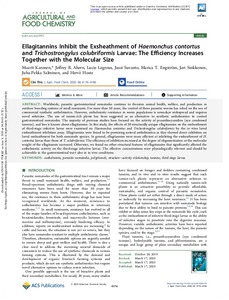Ellagitannins Inhibit the Exsheathment of Haemonchus contortus and Trichostrongylus colubriformis Larvae: The Efficiency Increases Together with the Molecular Size
Ahern JR; Karonen M; Suvanto J; Legroux L; Sinkkonen J; Salminen JP; Hoste H; Engström MT
Ellagitannins Inhibit the Exsheathment of Haemonchus contortus and Trichostrongylus colubriformis Larvae: The Efficiency Increases Together with the Molecular Size
Ahern JR
Karonen M
Suvanto J
Legroux L
Sinkkonen J
Salminen JP
Hoste H
Engström MT
AMER CHEMICAL SOC
Julkaisun pysyvä osoite on:
https://urn.fi/URN:NBN:fi-fe2021042822123
https://urn.fi/URN:NBN:fi-fe2021042822123
Tiivistelmä
Worldwide, parasitic gastrointestinal nematodes continue to threaten animal health, welfare, and production in outdoor breeding systems of small ruminants. For more than 50 years, the control of these parasitic worms has relied on the use of commercial synthetic anthelmintics. However, anthelmintic resistance in worm populations is nowadays widespread and requires novel solutions. The use of tannin-rich plants has been suggested as an alternative to synthetic anthelmintics to control gastrointestinal nematodes. The majority of previous studies have focused on the activity of proanthocyanidins (syn condensed tannins), and less is known about ellagitannins. In this study, the effects of 30 structurally unique ellagitannins on the exsheathment of third-stage infective larvae were examined on Haemonchus contortus and Trichostrongylus colubriformis by the in vitro larval exsheathment inhibition assay. Ellagitannins were found to be promising natural anthelmintics as they showed direct inhibition on larval exsheathment for both nematode species. In general, ellagitannins were more efficient at inhibiting the exsheathment of H. contortus larvae than those of T. colubriformis. The efficiency of inhibition increased as the degree of oligomerization or the molecular weight of the ellagitannin increased. Otherwise, we found no other structural features of ellagitannins that significantly affected the anthelmintic activity on the third-stage infective larvae. The effective concentrations were physiologically relevant and should be achievable in the gastrointestinal tract also in in vivo conditions.
Kokoelmat
- Rinnakkaistallenteet [19204]
